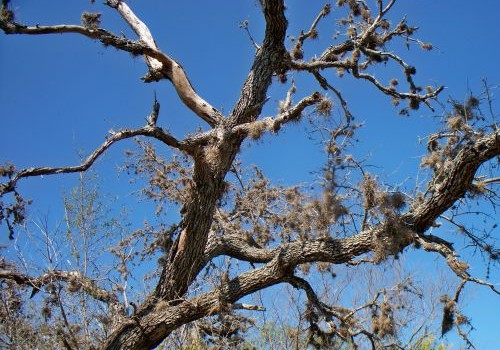 From October 2010 through September 2011, Texas received the least amount of precipitation recorded in a one-year period. The drought has had a major impact on Texas agriculture, with the toll more than $5 billion. Half the cotton crop had to be abandoned.
From October 2010 through September 2011, Texas received the least amount of precipitation recorded in a one-year period. The drought has had a major impact on Texas agriculture, with the toll more than $5 billion. Half the cotton crop had to be abandoned.
The Texas drought also made the state more vulnerable to wildfires. More than 21,000 wildfires burned nearly 3.7 million acres and 1950 homes, at a cost of $100 million.
The drought is still going on. North Texas homeowners are under mandatory restrictions for lawn watering and Central Texas rice farmers might not get any water for irrigation next year. The photos on this page are from South Texas at the beginning of September 2011 and mid-October 2011.
The tree in the first photo is a Texas live oak, an evergreen. It’s still alive – you can see a few dusty yellow leaves on some of the branches – but most of what you see on the tree is ball moss. Ball moss doesn’t derive nutrients from the tree, but it’s usually found on trees that are in serious decline.
 Lots of dry spindly gray plants in this photo. Some of those are dormant. Native Texas plants expect a few months of little to no rain each summer. The plants get most of their growing done during the wetter spring and fall. 2010 and 2011 were too dry during the rainy season, so many of the drought tolerant natives can’t make it through the heat.
Lots of dry spindly gray plants in this photo. Some of those are dormant. Native Texas plants expect a few months of little to no rain each summer. The plants get most of their growing done during the wetter spring and fall. 2010 and 2011 were too dry during the rainy season, so many of the drought tolerant natives can’t make it through the heat.
The green is mostly mesquite and some prickly pear cactus. Mesquite trees can withstand a significant drought, more even than the prickly pears.
 This creek bed is completely dry. Many creeks run dry in the heat of summer, but enough moisture will remain in the soil to sustain small plants.
This creek bed is completely dry. Many creeks run dry in the heat of summer, but enough moisture will remain in the soil to sustain small plants.
 Prickly pears can take a lot, but even they need some water. This one is hanging on. Wildlife eats the fruit of the cactus. Some will brave the long spines to eat the pads, if they’re hungry enough. Every scat I came across had plenty of seeds from the prickly pears.
Prickly pears can take a lot, but even they need some water. This one is hanging on. Wildlife eats the fruit of the cactus. Some will brave the long spines to eat the pads, if they’re hungry enough. Every scat I came across had plenty of seeds from the prickly pears.
 This field should look a lot nicer this time of year.
This field should look a lot nicer this time of year.
 Proper range management can go a long way to keeping the land green. This photo was taken in October, after several inches fell in a few days. The pasture maintained much of its ground cover, although the cattle received hay throughout much of the spring and summer. In South Texas, only the coldest months usually require feed supplementing.
Proper range management can go a long way to keeping the land green. This photo was taken in October, after several inches fell in a few days. The pasture maintained much of its ground cover, although the cattle received hay throughout much of the spring and summer. In South Texas, only the coldest months usually require feed supplementing.
 The creek from above after torrential rains. See the greening of the creek bed? In normal years, it would be much thicker.
The creek from above after torrential rains. See the greening of the creek bed? In normal years, it would be much thicker.
 Much of the brush will be slow to recover, but it’s gotten a little greener.
Much of the brush will be slow to recover, but it’s gotten a little greener.
 More brush looking a little greener.
More brush looking a little greener.
 These windmills used to be all over the place when I was a kid. Now I hardly ever see them. This one is on a museum grounds.
These windmills used to be all over the place when I was a kid. Now I hardly ever see them. This one is on a museum grounds.
The drought hasn’t ended, even though the native plants are looking a lot better. Texas is having a fairly dry winter. Hopefully, spring rains will be plentiful.
More reading:

You must be logged in to post a comment.